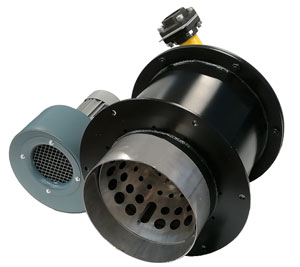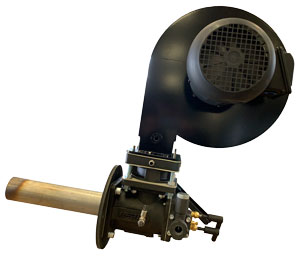A package burner is an industrial burner with its own dedicated blower. The standard scope of supply includes everything you need to safely run the burner: blower, air valve, air pressure switches, gas manifold (with filter, pressure reducing regulator, safety shut-off valves, gas pressure switches, etc.), ignition transformer, and flame safety. You are responsible for the gas and electric drops, but the idea is a package burner should be plug-and-play.
That doesn’t mean you’re without options. Customers often ask for some variation of the standard scope. You might want to provide the gas manifold and components yourself, or use a different flame safety, or change how the air is controlled. Maybe you need a special blower motor for your electric supply. Combustion is a high mix, low volume business, and many manufacturers recognize this and are prepared to work with you.
Package Burner Control Methods
It’s common to see either fixed air/modulating gas or fixed gas/modulating air control on a package burner. Of the two, we see fixed gas/modulating air most often.
In a fixed gas/modulating air scheme, the air flow is managed using a butterfly valve installed between the blower and the burner. An actuator drives the butterfly valve (there are options here, selected according to your application and need), and a cross-connected regulator maintains a constant gas-to-air ratio.
In a fixed air/modulating gas scheme, there is no valve between the blower and the burner, and the air flow is always the same. In a dual stage or modulating system, gas flow is modulated using a butterfly valve (or similar) with an actuator. In an on/off system, the modulating valve is omitted.
There are certainly other ways to manage package burners! This isn’t an exhaustive list. Please contact us if you’re curious about whether a package burner is right for you.
Applications
Package burners are popular for use in dryers, convection ovens for industrial food processing, and direct- or indirect-fired air heating applications. They’re also widely used in the textile industry, and in paint booths, ceramic kilns, and many others.
Benefits
Package burners are popular in situations where only one burner is needed, for obvious reasons, but they are also handy for applications where the equipment changes location. Without a central blower and air manifold to worry about, you’re limited only by where you can drop gas and electric.
You’ll find package burners in groups on large ovens, too. Imagine a convection oven running low temps with a lot of air movement. With a blower at each burner, you have options to create the ideal environment for an even bake.
A package burner’s pre-piped manifold will act as both a main gas train and burner train. This virtually ensures the oven won’t be forced down due to a failed regulator, pressure switch, or gas valve. You might lose an individual burner, but not the whole system.
If a package burner needs to be replaced, this can often be done with a quick operation, unmounting the old burner and mounting the new one. Of course, this is an extreme case. Most issues can usually be handled with spare parts.
Can you recommend a package burner?
Of course! ESA’s FC package burner are fixed air package burners. Use this model for on/off control, dual stage control, or modulating gas control.
The ESA EPB series utilize a butterfly valve for air control, and a cross-connected regulator to maintain a constant gas-to-air ratio.
For Automation
We believe in automation for all! Visit olstrad.com and contact us to learn how we can help you automate!













